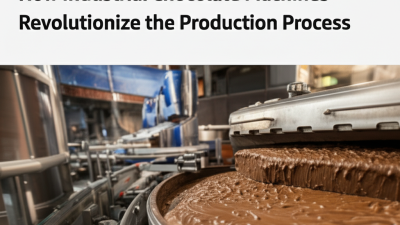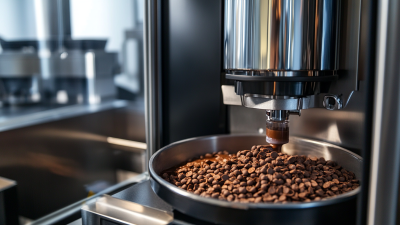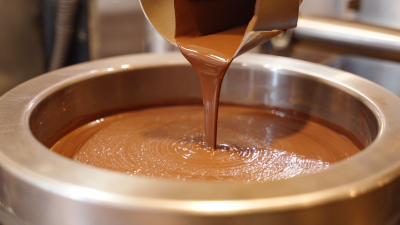The confectionery industry has undergone a significant transformation with the advent of advanced technologies, particularly the "Industrial Chocolate Machine." According to a recent report by Research and Markets, the global chocolate market is projected to reach a value of $161.56 billion by 2024, driven largely by innovations in production processes.  Industrial chocolate machines have revolutionized the way chocolate is produced, enabling manufacturers to increase efficiency, reduce waste, and enhance product consistency. With capabilities such as automated mixing, tempering, and molding, these machines not only improve the quality of the final product but also streamline operations, allowing companies to meet the growing consumer demand for chocolate. As the trend toward automation continues, investing in industrial chocolate machinery is becoming essential for businesses aiming to thrive in this competitive market.
Industrial chocolate machines have revolutionized the way chocolate is produced, enabling manufacturers to increase efficiency, reduce waste, and enhance product consistency. With capabilities such as automated mixing, tempering, and molding, these machines not only improve the quality of the final product but also streamline operations, allowing companies to meet the growing consumer demand for chocolate. As the trend toward automation continues, investing in industrial chocolate machinery is becoming essential for businesses aiming to thrive in this competitive market.
Industrial chocolate machines have transformed the chocolate production landscape, significantly enhancing efficiency across various stages of manufacturing. One of the most notable improvements comes from the automation and precision these machines provide. By streamlining processes such as grinding, conching, and tempering, they reduce the time required to produce high-quality chocolate. For instance, automated conching machines allow for consistent temperature regulation and mixing, ensuring a smoother texture and richer flavor while drastically cutting down on manual labor.
Furthermore, industrial chocolate machines facilitate improved scalability in production. With the ability to handle large volumes, these machines enable manufacturers to meet increasing consumer demand without sacrificing quality. They also incorporate advanced technology, such as smart sensors and data analytics, which optimize production parameters and enable real-time adjustments. This not only minimizes waste but also ensures that every batch meets strict quality standards. As a result, chocolate producers can enhance their efficiency and competitiveness in a rapidly evolving market while maintaining the artisanal quality that consumers expect.
| Dimension | Description | Impact on Efficiency |
|---|---|---|
| Production Speed | Industrial chocolate machines can produce up to 1,500 kg of chocolate per hour. | Increased output leading to higher profitability. |
| Automation | Machines automatically temper, mix, and mold chocolate. | Reduction of manual labor and errors. |
| Energy Efficiency | Modern machines use less energy compared to older models. | Lower operational costs and environmental impact. |
| Quality Consistency | Precise control over temperature and mixing ratios ensures uniform quality. | Enhances brand reputation and customer satisfaction. |
| Maintenance | Machines require less frequent servicing due to advanced technology. | Reduces downtime and maintenance costs. |
Automation in chocolate making has significantly transformed the industry, leading to unmatched consistency in product quality. Traditional methods of chocolate production often relied on skilled labor and artisanal techniques, which while charming, could result in variations in texture, flavor, and appearance. With the advent of industrial chocolate machines, factories can now standardize processes such as tempering, mixing, and molding. This precision ensures that every batch meets the same high standards, reducing the risk of defects and enhancing consumer satisfaction.
The integration of automation also permits real-time monitoring and adjustments throughout the production process. Advanced sensors and control systems can detect inconsistencies and rectify them on the fly, minimizing waste and maximizing efficiency. Additionally, automation allows for scalability, enabling manufacturers to produce large quantities of chocolate without compromising on quality. As a result, businesses can maintain a competitive edge while ensuring that customers receive a reliable and enjoyable product each time they indulge in chocolate.
The chocolate manufacturing industry is undergoing a significant transformation, owing to advanced technologies that streamline production processes and enhance product quality. Reports indicate that the global chocolate market is expected to reach $161 billion by 2024, growing at a CAGR of 4.5%. This growth is largely credited to the integration of industrial chocolate machines which have automated many traditional methods, increasing efficiency and reducing human error. For instance, the introduction of tempering machines ensures perfect crystallization, which is essential for achieving that coveted glossy finish and snap in chocolate bars.
Tips: When exploring new machinery for chocolate production, consider investing in machines that offer precise temperature control and high-speed processing capabilities. This can substantially improve the consistency and quality of your final product.
Moreover, the adoption of smart technology in chocolate production allows manufacturers to monitor and analyze data in real-time, optimizing their operations. A recent study found that manufacturers using advanced data analytics have reduced waste by up to 20%, significantly lowering operational costs. The ability to forecast demand trends through predictive analytics also aids in better inventory management and reduces excess production.
Tips: Implementing a data management system can be invaluable for tracking production metrics and ensuring optimal resource allocation. This not only enhances productivity but also facilitates quicker responses to market changes.
Investing in industrial chocolate machines significantly enhances production efficiency, ultimately saving both time and resources. These advanced machines
streamline the chocolate manufacturing process by automating key stages, enabling manufacturers to achieve higher output rates without compromising on quality. The use of technology in chocolate
production mirrors trends observed in other industries, such as the automating of timber fabrication, which has shown to reduce labor costs and improve turnaround times.
Tips for maximizing investment in industrial chocolate machines include conducting thorough research to choose the right equipment tailored to your production needs.
Regular maintenance and staff training are crucial to ensure optimal machine performance and longevity. Additionally, integrating software solutions for inventory and production management can
further enhance efficiency, making the entire process more synchronized and cost-effective. By adopting these practices, businesses can leverage the full potential of their chocolate production capabilities.
Sustainability practices are becoming integral to modern chocolate production systems, driven by increasing consumer awareness and demand for ethically sourced products. The integration of eco-friendly practices includes sourcing cocoa from certified organic farms, ensuring that farmers receive fair wages and practice environmentally responsible cultivation methods. This emphasis on sustainability not only helps preserve biodiversity but also safeguards the livelihoods of cocoa farmers, creating a more equitable supply chain.
Moreover, advanced industrial chocolate machines are designed to minimize waste and energy consumption throughout the production process. By optimizing energy use and reducing carbon footprints, manufacturers can produce chocolate in a more sustainable manner. Additionally, technologies such as closed-loop systems that recycle water and reduce emissions play a crucial role in aligning production methods with sustainable goals. As consumers continue to prioritize sustainability, chocolate producers are not only enhancing their brand image but also contributing to the overall health of the planet.






For more information, fill out our contact form